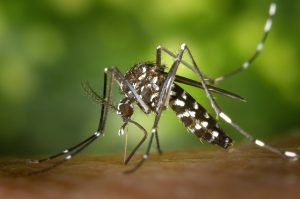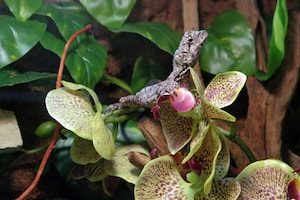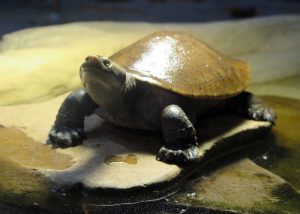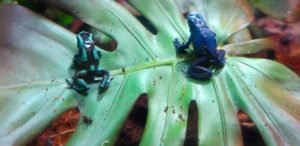5 Things I Learned: Anableps
Quickly swimming at the surface, Anableps anableps can be difficult to spot despite the fact that they swim in schools. Let’s get a closer look at these unique fish.
Nature. It’s a curious thing.
– Megan Brown, Intern
Quickly swimming at the surface, Anableps anableps can be difficult to spot despite the fact that they swim in schools. Let’s get a closer look at these unique fish.
Nature. It’s a curious thing.
– Megan Brown, Intern
Seahorses are one of the most well-known and recognizable creatures in the ocean. Their long snouts and curly tails are clear giveaways of their identities. However, these characteristics are not exclusively associated with seahorses. Located in the waters of southern Australia lives an obscure relative of the seahorse: the seadragon. Seadragons are in the same family as seahorses (Syngnathidae) but they are different in a number of ways. Seahorses are quite common and are found in tropical and subtropical waters all around the world, while seadragons are exclusively found near Australia. Also, there are many species of seahorses (around 47) and only three species of seadragons.
Aside from taxonomic classifications and geographic distributions, the main differences between seahorses and seadragons are physical. Seahorses are known for having a prehensile tail, which means they can use their tail to grasp onto things such as plants or even each other. Since seahorses are not good swimmers, the prehensile tail allows them to anchor themselves so they do not get swept away by currents and can remain hidden from predators. Seadragons lack this prehensile tail and rely on camouflage to avoid predation. They have leaf-like appendages to resemble the underwater plants around them, allowing them to blend into their surroundings. In addition, seadragons have slightly longer snouts than their seahorse relatives.
Another one of the main differences between seahorses and seadragons is the way they carry their young. Both seahorse and seadragon young are carried by the males, but in different ways. Seahorse males have a fully enclosed pouch into which females deposit eggs; the males carry those eggs until the young hatch. Seadragon males have a spongy patch located underneath their tail where they carry the eggs.
Besides these main differences, seahorses and seadragons are actually quite similar. At the Greater Cleveland Aquarium, we have one seahorse and one seadragon species. The next time you visit, keep an eye out for the potbelly seahorse (Hippocampus abdominalis) and the weedy seadragon (Phyllopteryx taeniolatus) and see if you can notice their differences!
Want to know more?
• Kelly, Jasey. “The Differences between the Sea Dragon & Seahorse.”
• MarineBio. “Leafy Sea Dragons, Phycodurus eques.”
• Ocean Conservancy. “Wildlife Fact Sheets: Seahorse.”
– Charlotte
Coral reefs are some of the most important habitats that have developed over hundreds of millions of years on Earth. Most people believe that corals are plants, but they are actually invertebrates with simple stomachs and a single mouth, much like jelly fish and sea anemone. Although they roughly occupy less than 1% of the ocean floor, coral reefs are home to about 25% of all ocean species! They comprise the largest living structure in the world and can even be seen from outer space, and with all that biodiversity they are important to much more than just themselves. Unfortunately, coral reefs are diminishing right before our eyes with climate change, greenhouse gas emissions, and ocean acidification altering our oceans water chemistry.
Ocean acidification has caused the chemistry of our oceans to change drastically in a relatively short period of time. Since the industrial revolution, the burning of fossil fuels for cars, industries and electricity has left the world in a cloud of continual CO2 emissions that collect in the atmosphere. With our oceans taking up about two-thirds of Earth’s surface, they are the largest source of CO2 removal from air. The oceans remove about one-third of all CO2 emissions from the atmosphere, but when too much carbon dioxide is absorbed into our oceans it can be harmful to the animals living within them.
When CO2 is introduced to saltwater, it causes complex chemical reactions that ultimately increase the acidity of the water. Ocean water pH stayed stable over the last 300 million years, around 8.2, which is the most comfortable region for corals to grow and flourish. Since the industrial revolution, we have seen a pH shift from 8.2 to around 8.1 and 8.0 in certain regions of the world. Although a 0.1 or 0.2 decrease in pH seems extremely small, it actually accounts for a 25% increase in acidity in only 100 years! These drastic changes in the pH and temperature of the oceans in a very short period has left many of our animals in shock, especially our corals.
Corals natural environment and comfortable living conditions are quickly changing in a way that’s not unlike animals that lose their habitats to deforestation or natural disasters. Most corals are not able to acclimate to the more acidic environments that have come about in the last 100 years. In turn, corals become so stressed out by the changing water chemistry that they ultimately undergo coral bleaching events.
Individual corals are called polyps and multiple coral polyps in an area are called a colony. There are both hard and soft corals that live in the ocean, but most of us have seen hard corals that live in shallow tropical waters. These hard corals have a calcium carbonate structure that would be similar to our bones. Polyps grow off this skeleton that contain algae called zooxanthellae. Zooxanthellae not only give corals their bright, vibrant colors, but also support the life of these corals by helping trap food and offering protection.
During coral bleaching, acidic waters cause corals to “kick out” the zooxanthellae living in their polyps. Once this happens, the coral is not able to protect itself or get the food it needs and in turn, the polyps begin to peel off the skeleton like fleshy material until only the calcium carbonate skeleton is left.
So why should we care about coral bleaching? First of all, corals are one of best places for life to flourish! With nearly 25% of all ocean species living on or near coral reefs, they offer homes, protection and food for many animals. Coral reefs are also a great barrier to coastal areas when there are hurricanes and rough waters as they block water from flooding and destroying natural coastal regions. Additionally, tourism in many places will drop off without the reefs. Some regions depend on the natural beauty of coral reefs as a source of income for aquatic excursions.
Even though it might sound like corals as we know them have come to their end, there are steps we can take to have a positive impact. Educating ourselves and others about the harmful effects of CO2 emissions is a critical step. Emphasizing careful viewing of corals is also important. (Humans shouldn’t touch, pick up or take home wild corals any more than we should sharks, eels, jellyfish and other living things.) We can support research institutions such as Mote Marine Laboratory or the Coral Restoration Foundation Education Center that are devoted to learning more about coral and saving our reefs. And, most directly, we can cut down on our CO2 emissions in any way possible. This could mean using less energy and water at home, riding bikes to school or carpooling to the places you need to go, recycling products we use every day and making sure we aren’t polluting our water ways. For more information about coral bleaching, check out Chasing Corals, an amazing Netflix documentary that shows the harmful effects of coral bleaching and highlights some of the great people out there working to restore our reefs. https://www.youtube.com/watch?v=b6fHA9R2cKI
It might be hard to find a bushynose pleco, but that’s by design! Take a closer look at this bristlenose catfish in the video below.
Nature. It’s a curious thing.
– Hannah
Fishing is a popular outdoor hobby for many people. In fact, anyone older than 16 can purchase a fishing license in Ohio. Some of the most popular sport fish in this region are bass, walleye, catfish and perch.
With any outdoor activity there are environmental risks that we can help minimize. Being aware of our impact on our natural ecosystems is an important step in protecting the planet. Here are a few ways you can help reduce your effect on our environment while still enjoying your favorite pastime.
Break it Down Now
Although biodegradable fishing line can be hard to find, it can help reduce the amount of harm done by leftover fishing line. Regular fishing line takes about 600 years to decompose while biodegradable options can take as little as 2 years. If biodegradable, isn’t an option then make sure you’re being cautious about where your extra line ends up. Clean up after yourself whenever possible.
No Lead, No Problems
Many fishing weights and other equipment contain lead. High levels of lead in water bodies can poison fish and other wildlife. Using weights made with brass, steel, bismuth tin, iron or tungsten will lessen the amount of lead that end up in our waterways.
Eyes as Big as Your Stomach
In addition to adhering to local catch-and-release fishing regulations, it’s important to only take the fish you know you can use. Only keeping the fish you know you will use is more sustainable and reduces the amount of bycatch.
All about the Baits
Most bait, such as worms or other fish aren’t naturally found in the environments where they are used. High levels of this non-native bait can disrupt the natural ecosystems and cause issues within the food chain. Make sure to use only the bait you need and to take any leftovers with you for proper disposal.
Row, Row, Row Your Boat
Motorized fishing boats release carbon emissions into the environment that can be harmful to the local wildlife. Whenever possible, try using a rowboat or canoe to fish. There are also special boat propellers that can increase fuel efficiency by more than 20%.
Talkin’ Trash
The biggest thing you can do when enjoying any outdoor activity is clean up after yourself! Taking all your belongings and trash with you ensures that nothing ends up where it shouldn’t be.
– Caroline
Did you know that the Florida Museum of Natural History documents all known shark attacks? They started the ISAF (International Shark Attack File) back in 1958. If we use the data collected to average fatalities from sharks over the last 60 years, the number is only 7 per year worldwide. If you put that into odds, it is 1 in 3,700,000. Now let’s compare that with the odds of dying from the flu, which is 1 in 63.
Turns out there are lot of things more dangerous than sharks, but we don’t seem to be afraid of them. So let’s take a look at what SHOULD scare us more than sharks.
How about bugs? Those annoying mosquitos are responsible for 800,000 deaths a year. Fire ants account for another 50 people and bees will kill 100 people in the U.S. alone. Those are large numbers for being such small animals.
There are plenty of other animals more dangerous to humans than sharks. Take, for example, the noble steed. Yup, horses kill about 20 people in the U.S. per year. Then there’s the loyal dog. (What can be better than a lick in the face from our beloved friend?) Turns out, dogs are responsible for 25,000 human deaths annually worldwide. And how about Bambi? Such a cute little creature, but deer are the reason 130 people die each year in the U.S. It seems cars and deer do not like each other very much.
So let’s focus on the automobile. There are more than 1.2 million traffic-related deaths every year. Traffic lights will be part of that with 2,000 deaths in the U.S. alone. People just ignore those lights but that could be because we’re all wrapped up in our online worlds. Cell phones should be far more feared than our finned-friends since 6,000 deaths in the U.S. are attributed to texting and driving.
Now that you have considered how dangerous the roads can be, perhaps you will decide to start walking more. Be forewarned—almost 6,000 people die every year from trips and falls. And if that (or any of these statistics) make you want to never leave your home, just remember that on average 450 people in the U.S. die from falling out of that bed, 26 people are crushed by sofas, and 30 folks are done in by falling televisions.
Hey, get outside already, go cut the lawn it is excessively high, but then you may be thinking about the 75 people in the U.S. that die from lawnmower accidents or the 24,000 people that die from lightning strikes every year. (Are those clouds over there?) Oh well, all this is making me hungry. Let us go wash up and go have some dinner, but watch out for the hot water. In the U.S., scalding tap water will kill 100 people this year. And oh, by the way, food—the very thing that keeps us alive—holds potential dangers. The World Health Organization estimates that about 420,000 people die yearly from contaminated food. (Five thousand of those are from contaminated raw meat within the U.S. alone.) Another 3,000 people a year die from choking and the National Institutes of Health has calculated that obesity is killing almost 300,000 people a year. And if you eat out often, take care when you sign your restaurant check because believe it or not, ballpoint pen caps are responsible for taking out 100 people per year.
So now that you are totally stressed out by these statistics, take a walk on the beach and try not to trip. However, watch out for the falling coconuts since they will add 150 people a year to that list of fatalities.
Let us celebrate being alive and safe from those sharks, but watch the champagne corks during that celebration so you do not add to the approximate 25 people per year that are killed by those projectiles!
– Matthew Ballish
Once upon a time, reptiles and amphibians were classified together as one family. Scientists believe that reptiles evolved from their relative amphibians about 50 million years ago.
Today it still can be difficult to identify all of the differences between reptiles and amphibians. They definitely have traits they share. For example, they are both ectothermic, or cold-blooded animals, meaning their body temperature relies on the temperature of their habitat. Reptiles and amphibians also are both vertebrate animals, meaning they have backbones. Reptiles and amphibians also both have excellent eyesight that helps them hunt prey.
Reptiles and amphibians use many common defense mechanisms. Some species of both reptiles and amphibians have the ability to change the color of their skin in order to camouflage in their habitat. Another major defense tactic used by reptiles and amphibians is what scientists call mimicry. Copycat species, some reptiles and amphibians, mimic the bright colors of venomous or poisonous species to ward off predators.
While they clearly have a lot in common, there are some major differences.
All reptiles breathe through their lungs. Turtles are reptiles and some turtles have the additional ability to absorb and dispel gas when underwater during their brumation, or hibernation state. Reptiles also typically have dry, scaly and water-tight skin that offers protection. Reptiles with softer skin are usually equipped with another defense – like the hard shell of a turtle or the spines of a lizard. Reptiles do not live solely in water but normally need to live close to a constant water source.
In addition to breathing through lungs, amphibians can breathe through gills, or through their smooth, moist skin. This is what scientists call cutaneous respiration and amphibians are some of the only animals on the planet that have this ability! This allows for amphibians to live in water for extended periods of time. Some amphibians begin their lives in water and then move to land. Frogs are amphibians that start as tadpoles, completely submerged in water and breathing through their gills, and then move to land as adults once their lungs are fully developed.
While reptiles and amphibians share similarities they have distinct points of differentiation that make them unique. Scientists estimate there are about 8,000 species of reptiles and around 6,000 species of amphibians, and we will continue to learn more about what sets them apart as we continue to study these species.
– Elise
One of the most biodiverse ecosystems in the world, coral reefs are in serious peril. Coral reefs take up about 1% of the ocean floor but are home to 25% of all ocean species including more than 4,000 species of fish.
What is a coral reef?
Coral reefs are colonies of individual animals called polyps. The polyps have tentacles to feed on plankton at night and they play host zooxanthellae—symbiotic algae that live within the coral’s tissues and gives them color. The algae need carbon dioxide and waste products from the coral for photosynthesis. In turn, through photosynthesis the algae nourish the coral with oxygen and organic compounds. The coral uses these compounds to synthesize calcium carbonate (limestone) with which it constructs its skeleton. This skeleton contains bands, like tree rings, that record environmental changes in temperature, water chemistry and water clarity.
Why should we care about coral reefs?
Coral reefs are also known as the speed bumps of the ocean. These structures act as a natural barrier, helping to slow down and shrink waves hurtling toward the shoreline and thereby protecting coastlines and the 200 million people living along the coasts from hurricanes.
We receive many other benefits from coral reefs. Stationary animals, coral are constantly evolving chemical defenses as protection from predators. Scientists are developing new medicines from the coral-produced compounds to help treat cancer, arthritis, bacterial infections, Alzheimer’s disease, heart disease, viruses and many others.
Coral reefs also provide us with food and construction materials. They also contribute heavily to the economy via tourism.
Why are coral reefs endangered?
Believe it or not coral reefs can get stressed out! There are a variety of different factors that contribute to the stress of coral reefs. For example, rising temperatures globally causes coral bleaching. Also, additional carbon dioxide oceans absorb every day contributes to increased acidification which reduces the water’s ability to carry the calcium carbonate that corals need to build skeletons.
Additionally, overfishing is changing the coral reefs ecosystem with anchors and nets destroying the natural habitat. And when sediment and other pollutants settle on coral reefs it can speed the growth of damaging algae and lower overall water quality. With lower water quality the sunlight may not be strong enough to reach the zooxanthellae to go into photosynthesis.
How can we help?
Scientist are working to find some solutions, but all of us can join the effort to help coral reefs by reducing our carbon footprints. Try recycling or using more reusable products. Join the skip-the-straw movement reducing single-use plastic waste. Only eat fish sourced sustainably. Or, donate to organizations and support companies committed to cleaning up our oceans.
-Crystal
Shark reproduction is pretty strange to begin with. But for sand tiger sharks, it is even weirder.
Sand tigers are the largest sharks you’ll see at the Greater Cleveland Aquarium. Their mating behavior is pretty ferocious.
We don’t know what prompts female sand tigers to be ready to mate. They must be mature enough in age—somewhere in their teens—and the females must also be ready to mate, which happens about every two years. We are not sure how (or if) females select mates. Scientists are still studying this!
When sand tigers mate, the much smaller males must bite and forcibly flip over the much larger and thicker-skinned females.
But before the sharks get to that point, there is a period of courtship behavior—sort of like shark dating.
Males might follow a female, swimming behind and slightly below her in the water. Then he might escalate to tailing, during which he very closely follows her. The next step is nosing. The male will follow the female very closely, with his nose, or rostrum, very close to her cloaca. (The cloaca is a shark’s reproductive canal and its way to poop. Both males and females have a cloaca.) Then the male will nudge the female, then bite her fins or body—all the while hoping to bite her and flip her over to mate.
If the male is successful, he will bite the female on the pectoral (arm-position) fin and try to flip her over. She then will become catatonic and will allow mating.
But, if the female is not interested at any point, she may bite the male right back! And remember, the females are much larger and thicker-skinned than the males. Female sand tigers can also circle close to the bottom to prevent males from approaching her to bite.
If the female is interested in mating, she may point her nose downward and allow the male a better chance to bite her.
Then the male sand tiger can hold the female’s cloaca with his clasper. Claspers are two finger-like appendages that all male sharks, skates, and rays have behind their pelvic fins. The male can then deliver his sperm, cloaca to cloaca before swimming away.
The female can store the male’s sperm for an unknown amount of time—perhaps a year, perhaps more—until it seems a good time to carry pups.
Now things get even stranger.
The female sand tiger has two uteruses. So sand tigers can carry two totally separate pregnancies.
Since sand tigers are ovoviviparous, they lay eggs internally and then give live birth. But for sand tigers, life starts under difficult circumstances. Around 20 eggs may be fertilized in each uterus. Then the eggs develop into shark embryos. The embryos grow bigger and consume all the nutrition in their individual eggs.
Then the biggest, strongest sand tiger pup in each uterus eats all of its siblings. Intrauterine cannibalism! That is what scientists call it.
The surviving sand tiger pup eats whatever new eggs keep arriving in the uterus until it is ready to be born.
After eight or nine months’ gestation, the pup is born. It will be more than three feet long and totally independent immediately.
Scientists are still learning about sand tiger shark reproduction. At the Greater Cleveland Aquarium we have seen mating behavior, but no pups yet.
– Nora Morrison